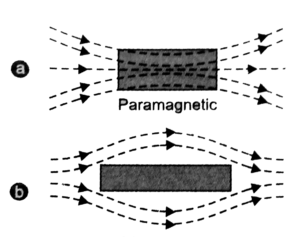Table of Contents
Paramagnetic Material is a property of certain materials that causes them to be weakly attracted to magnetic fields. When these materials are exposed to an external magnetic field, internal induced magnetic fields form that are ordered in the same direction as the applied field.
When the applied field is removed, the materials lose their magnetism because thermal motion randomizes the electron spin orientations. Paramagnetically active materials are referred to as paramagnetic.
Under certain conditions, some compounds and most chemical elements are paramagnetic. On the other hand, true paramagnets exhibit magnetic susceptibility according to the Curie or Curie-Weiss laws and paramagnetism over a wide temperature range. Myoglobin, transition metal complexes, iron oxide (FeO), and oxygen are all examples of paramagnets (O2).
Titanium and aluminium are paramagnetic metallic elements. Superparamagnets are materials with a net paramagnetic response but microscopic ferromagnetic or ferrimagnetic ordering.
These materials obey the Curie law while having extremely large Curie constants. Superparamagnets are examples of ferrofluids. Mictomagnets are another name for solid superparamagnets. A micromagnetic is an alloy such as AuFe (gold-iron). The alloy’s ferromagnetically coupled clusters freeze below a certain temperature.
Paramagnetic Materials
Because unpaired electrons exist in paramagnetic materials, the net magnetic moment of all electrons in an atom does not equal zero. As a result, an atomic dipole exists in this case. When an external magnetic field is applied, the atomic dipole aligns in the direction of the external magnetic field. Paramagnetic materials are thus weakly magnetised in the direction of the magnetising field. In layman’s terms, these materials typically have a weak attraction to magnets. Paramagnetism is the name given to this type of magnetism. It is caused primarily by unpaired electrons in the material or by the partial alignment of randomly oriented atomic dipoles along the field.
Also Read: Important Topic of Physcis Magnetic Properties

There are two types of paramagnetism.
- The magnetic moments in the first type are found in low concentrations, causing them to separate from one another. Their spins do not interact either.
- Paramagnetism occurs in the second type as a result of interactions between magnetic moments. The interactions are very weak in this case. As a result, there is no net magnetization when the applied field is zero.
M = χH = C/T x H
Where,
M stands for magnetization.
χ= susceptibility to magnetic fields,
C denotes the material-specific Curie constant.
T denotes the absolute (Kelvin) temperature.
H denotes the auxiliary magnetic field.
Download Free PDF Important Questions for Class 12 Physics Chapter 5 Magnetism and Matter
Properties of Paramagnetic Materials
- When an atom’s net atomic dipole moment is greater than zero, paramagnetic substances have a permanent dipole moment due to unpaired spin. The magnetic field attracts the substances only weakly.
- Paramagnetic substances move from a weak field region to a strong field region in a non-uniform external magnetic field. Because the field is strongest near the poles, a paramagnetic rod aligns itself parallel.
- A paramagnetic liquid ascends in the limb between the magnet’s poles in a U-Tube.
- The magnetization intensity is very low, positive, and directly proportional to the magnetising field.
- The magnetic susceptibility is low and positive.
- The relative permeability is a little higher than one. The magnetic field within the material is greater than the magnetising field.
- Inside paramagnetic substances, magnetic field lines become denser. The magnetization of paramagnetic substances is proportional to their absolute temperature.
- According to Curie’s law, magnetic susceptibility is inversely proportional to Absolute Temperature in paramagnetic substances.
- Paramagnetic substances have a small magnetic dipole moment parallel to the magnetising field.
FAQs
What exactly is a paramagnetic material?
Metals that are weakly attracted to magnets are known as paramagnetic materials. Aluminium, gold, and copper are among them. These substances' atoms contain electrons, the majority of which spin in the same direction... but not all. This imparts polarity to the atoms.
What is a paramagnetic material, and what are some examples?
Unpaired electrons have a magnetic dipole moment due to their spin and act like tiny magnets. When an external magnetic field is applied, the spins of the electrons align parallel to the field, resulting in a net attraction. Aluminium, oxygen, titanium, and iron oxide are examples of paramagnetic materials (FeO).
What exactly are paramagnetic solids?
Paramagnetic substances are solids that are weakly attracted by a magnetic field. They are magnetically oriented in the same direction as the magnetic field. These aren't strong magnets. When a magnetic field attracts one or more unpaired electrons, paramagnetism occurs.



